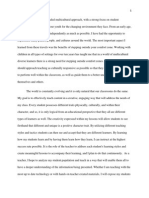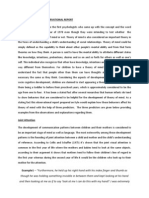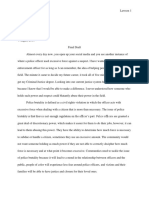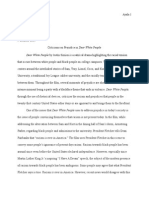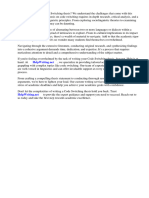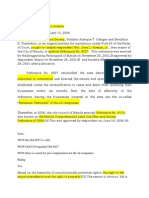Confronting Ableism
Confronting Ableism
Uploaded by
Adam MendelsonCopyright:
Available Formats
Confronting Ableism
Confronting Ableism
Uploaded by
Adam MendelsonCopyright
Available Formats
Share this document
Did you find this document useful?
Is this content inappropriate?
Copyright:
Available Formats
Confronting Ableism
Confronting Ableism
Uploaded by
Adam MendelsonCopyright:
Available Formats
Adam Mendelson 2 September 2011 Inclusive Practices
Confronting Ableism
This article discusses the negative cultural attitudes toward students with disabilities and how it can undermine opportunities for all students to participate fully in school and society. The author coins the term ableism, as societys pervasive negative attitude about disability. As unfortunate and sad as the truth may be, it is a reality that teachers must confront. Students and teachers alike may have a difficult time understanding and accepting ones disability, and in turn, isolate the student with the disability. In education, considerable evidence shows that unquestioned ableist assumptions are harming disabled students and contributing to unequal outcomes. Special education in the school system includes programs such as the IEP and the IDEA, which will meet and embrace the unique needs that arise out of the students disability. I am a strong supporter and believer in Special Education for many reasons. I have seen first hand the success of the teachers who spend their time with students with disabilities. I have seen children with Down syndrome included in normal class activities and enjoy them and feel like they belong. To give a student support, skills, and opportunities needed to live as full a life as possible is the goal of special education instructors. The hard work, patience, and commitment to ableist students are noble and honorable. It takes a person with a strong heart and dedication to teach Special Education, and I respect any instructor involved in Special Ed. This article also discusses in length about students with various types of disabilities and how to go about supporting and educating them. Disabilities include
students with a Serious Emotional Disturbance, students with Learning Specific Disabilities, and Students with Low- Incidence Disabilities. Low incidence disability students, like blindness and deafness, unfortunately are not afforded opportunities that other children with the same disability had in the past. Parents sometimes face the choice of sending their children to a local school that is ill equipped to meet their needs. Services can be brought to blind and deaf students in typical community settings, and most students can thrive in that environment. Students that have serious emotional disturbances experience poorer outcomes than those students of Low-Incidence disabilities. Substantial evidence indicates, that providing these students with appropriate supports and mental health services can significantly reduce disruptive behavior and improve their learning. We must remember that the most damaging ableist assumption is the belief that people with disabilities are not intellectually capable. This discourages students and gives them lower expectations. We must encourage any and all students with disabilities and provide the support and services they deserve to get the best education they can receive.
You might also like
- Youth Competition Times 22 23 Complete GK Book Pdfenglish MediumDocument297 pagesYouth Competition Times 22 23 Complete GK Book Pdfenglish MediumSubhadip Goswami100% (3)
- Psych 250 Parent Interview Essay - Frida eDocument11 pagesPsych 250 Parent Interview Essay - Frida eapi-644126308No ratings yet
- Conducting and Writing Minutes of The Meeting PPT FinalDocument46 pagesConducting and Writing Minutes of The Meeting PPT Finaljeysah sandovalNo ratings yet
- Cultural Styles of TalkDocument6 pagesCultural Styles of TalkCemone C.No ratings yet
- Sped PortfolioDocument29 pagesSped Portfolioapi-510352498No ratings yet
- Educational Philosophy Draft 2Document3 pagesEducational Philosophy Draft 2api-290850045No ratings yet
- Educational PhilosophyDocument3 pagesEducational Philosophyapi-270231720No ratings yet
- Germany and The Second World War - Volume I - The Build-Up of German Aggression (PDFDrive)Document809 pagesGermany and The Second World War - Volume I - The Build-Up of German Aggression (PDFDrive)Parabellum100% (6)
- Edu 290 Diversity PaperDocument10 pagesEdu 290 Diversity Paperapi-531486255No ratings yet
- Bretts Developmentally Appropriate EducationDocument31 pagesBretts Developmentally Appropriate Educationapi-457699298100% (1)
- Lesson Plan Format Student - Veronica Fox - Subject/Concepts - Art - Grade Level: KindergartenDocument8 pagesLesson Plan Format Student - Veronica Fox - Subject/Concepts - Art - Grade Level: Kindergartenapi-506074140No ratings yet
- Family Partnership PlanDocument5 pagesFamily Partnership Planapi-446057664100% (1)
- Universal Preschool Is No Golden Ticket: Why Government Should Not Enter The Preschool Business, Cato Policy Analysis No. 333Document31 pagesUniversal Preschool Is No Golden Ticket: Why Government Should Not Enter The Preschool Business, Cato Policy Analysis No. 333Cato InstituteNo ratings yet
- Theory PaperDocument16 pagesTheory Paperapi-531236909100% (1)
- Theory of Mind: An Observational ReportDocument3 pagesTheory of Mind: An Observational ReportMalavika MenonNo ratings yet
- Senior Project - Research Paper FinalDocument23 pagesSenior Project - Research Paper Finalapi-348553585No ratings yet
- The Mythical Norm: Diversity, Crime and Justice in Canada, Edited by Barbara Perry, Pp. 57-72. ©Document16 pagesThe Mythical Norm: Diversity, Crime and Justice in Canada, Edited by Barbara Perry, Pp. 57-72. ©alex davidNo ratings yet
- Grade/Class/Subject:: MSMU Lesson Plan FormatDocument8 pagesGrade/Class/Subject:: MSMU Lesson Plan Formatapi-547294586No ratings yet
- Chapter1-2 - Impact of Black Teachers On Black Student's AchievementsDocument13 pagesChapter1-2 - Impact of Black Teachers On Black Student's AchievementsLoisNo ratings yet
- Child 230-Dap PaperDocument7 pagesChild 230-Dap Paperapi-512229114No ratings yet
- Parent Presentation FinalDocument20 pagesParent Presentation Finalapi-246379610100% (1)
- Resetting Mindsets About DisabilityDocument3 pagesResetting Mindsets About DisabilityWonderfullyANo ratings yet
- Creating A Culture Friendly EnvironmentDocument12 pagesCreating A Culture Friendly EnvironmentMuhammad Zul AizzatNo ratings yet
- Essay 1Document5 pagesEssay 1api-520462773No ratings yet
- Bilingual Education in TZDocument17 pagesBilingual Education in TZizielskeNo ratings yet
- Diversity 1Document8 pagesDiversity 1api-553452414No ratings yet
- Reflective Writing - Gender Class and InclusionDocument4 pagesReflective Writing - Gender Class and Inclusionapi-487664247No ratings yet
- Multicultural EducationDocument28 pagesMulticultural EducationJhairaCresFernandez100% (1)
- Implicit Bias Against International Students: Student Name University Affiliation Professor Course DateDocument6 pagesImplicit Bias Against International Students: Student Name University Affiliation Professor Course DateKing Mashe UltimatelyNo ratings yet
- Classroom Observation 1Document5 pagesClassroom Observation 1api-241268840No ratings yet
- Kroneman CapstoneDocument22 pagesKroneman Capstoneapi-504044748No ratings yet
- Cultural CompetenceDocument2 pagesCultural Competenceapi-461480866No ratings yet
- Human Development - Nature V NurtureDocument3 pagesHuman Development - Nature V Nurtureapi-261407212No ratings yet
- White PrivilegeDocument6 pagesWhite Privilegeapi-356398334No ratings yet
- Sociocultural Identity Essay ExplanationDocument6 pagesSociocultural Identity Essay Explanationapi-353819251No ratings yet
- Authentic AssessmentDocument7 pagesAuthentic Assessmentapi-331383409No ratings yet
- Developmentally Appropriate Play Professional DevelopmentDocument35 pagesDevelopmentally Appropriate Play Professional Developmentapi-550630285No ratings yet
- Culturally Responsive School LeadershipDocument8 pagesCulturally Responsive School Leadershipapi-326382783No ratings yet
- Police BrutalityDocument13 pagesPolice Brutalityapi-466414033No ratings yet
- What Is DiversityDocument18 pagesWhat Is DiversityChris John J. SinsNo ratings yet
- African American WomenDocument8 pagesAfrican American Womenapi-314538346No ratings yet
- Setting ObservationDocument6 pagesSetting Observationapi-456995798No ratings yet
- Multicultural PhilosophyDocument7 pagesMulticultural Philosophyapi-307141452No ratings yet
- Self Refloective EssayDocument5 pagesSelf Refloective EssayMarlee WhiteNo ratings yet
- Advocacy Plan FinalDocument14 pagesAdvocacy Plan Finalapi-583336226No ratings yet
- Dap PaperDocument7 pagesDap Paperapi-339989449No ratings yet
- What Is Child Abuse and Neglect?Document8 pagesWhat Is Child Abuse and Neglect?Astari ArfianaNo ratings yet
- Implicit BiasDocument4 pagesImplicit Biasapi-531608214No ratings yet
- Online Assignment #3 Childhood TraumaDocument8 pagesOnline Assignment #3 Childhood TraumaRei VuksaniNo ratings yet
- Psych 250 Paper FinalDocument8 pagesPsych 250 Paper Finalapi-546733227No ratings yet
- Unconscious BiasDocument7 pagesUnconscious Biasapi-406144334No ratings yet
- Dap 2020Document4 pagesDap 2020api-523044836No ratings yet
- Media Children Indpendent Study-4-2Document21 pagesMedia Children Indpendent Study-4-2api-610458976No ratings yet
- Redefining The Role of The TeacherDocument4 pagesRedefining The Role of The TeacherJavier DominguezNo ratings yet
- Dear White People by Justin Simien Is A Satirical Drama Highlighting The Racial TensionDocument7 pagesDear White People by Justin Simien Is A Satirical Drama Highlighting The Racial Tensionaayala4No ratings yet
- Disabilites NotebookDocument5 pagesDisabilites Notebookapi-649553832100% (1)
- Educational PhilosophyDocument5 pagesEducational Philosophyapi-299174937100% (1)
- Assessment 1Document13 pagesAssessment 1api-297389221100% (1)
- Sex EdDocument18 pagesSex Edjoeriz jillNo ratings yet
- Final Draft Personal Essay - Nikhila LampmanDocument8 pagesFinal Draft Personal Essay - Nikhila Lampmanapi-437407222100% (1)
- Early Childhood Education PhilosophyDocument3 pagesEarly Childhood Education PhilosophyHa HangNo ratings yet
- Module 1 - Diversity Classroom ManagementDocument4 pagesModule 1 - Diversity Classroom Managementapi-263918338No ratings yet
- Understanding Shared Services in Early Childhood EducationFrom EverandUnderstanding Shared Services in Early Childhood EducationNo ratings yet
- Pakistan Movement 1940 - 1947: Lahore Resolution 1940Document10 pagesPakistan Movement 1940 - 1947: Lahore Resolution 1940Anas jahangirNo ratings yet
- 14th PMA Academic Portion by Syed Abdul BasitDocument3 pages14th PMA Academic Portion by Syed Abdul Basitmudassirjaleel07No ratings yet
- 2016 APSA Program AdDocument1 page2016 APSA Program AdRandomHouseAcademicNo ratings yet
- People v. UrsuaDocument2 pagesPeople v. UrsuaMaria AnalynNo ratings yet
- Ictimai Siyasi Metnlerin TercumesiDocument6 pagesIctimai Siyasi Metnlerin Tercumesisabmva120No ratings yet
- Gibbs V RodriguezDocument3 pagesGibbs V RodriguezJoey PastranaNo ratings yet
- Code Switching ThesisDocument4 pagesCode Switching Thesisconnierippsiouxfalls100% (1)
- Hickey v. Voxernet, 12-Cv-00373 (W.D. Wash. Aug. 13, 2012)Document11 pagesHickey v. Voxernet, 12-Cv-00373 (W.D. Wash. Aug. 13, 2012)Venkat BalasubramaniNo ratings yet
- Export Procedures and Documentation PDFDocument2 pagesExport Procedures and Documentation PDFJames0% (1)
- Hong Kong Infrastructure Development (Final)Document34 pagesHong Kong Infrastructure Development (Final)IJMacDNo ratings yet
- U.S Sanctions On Burma.Document28 pagesU.S Sanctions On Burma.SukiNo ratings yet
- Senarai Nama Guru Terkini 24.3.2023Document2 pagesSenarai Nama Guru Terkini 24.3.2023Furaiha SegamatNo ratings yet
- Principles in EthiopiaDocument2 pagesPrinciples in EthiopiasineNo ratings yet
- Herget Wayne Christine 1991 HaitiDocument7 pagesHerget Wayne Christine 1991 Haitithe missions network100% (1)
- Lbe - Case Study 1-1Document3 pagesLbe - Case Study 1-1Koshlesh BhardwajNo ratings yet
- Pesigan V AngelesDocument2 pagesPesigan V AngelesFrances Angelica Domini KoNo ratings yet
- SKB 2024 12488 AcknowledgementDocument1 pageSKB 2024 12488 AcknowledgementShafiq IslamNo ratings yet
- The Chorzow Factory Case (1928, Germany V Poland)Document1 pageThe Chorzow Factory Case (1928, Germany V Poland)Ric SaysonNo ratings yet
- Review of The SADC Inclusive Education StrategyDocument11 pagesReview of The SADC Inclusive Education StrategyGeorge Mwika KayangeNo ratings yet
- Philippine HistoryDocument14 pagesPhilippine HistoryjulietpamintuanNo ratings yet
- DutiesDocument3 pagesDutiesnamratadgc9629No ratings yet
- Quit India MovementDocument2 pagesQuit India MovementSiddharth GopalNo ratings yet
- Social Justice Society Vs Atienza DigestDocument2 pagesSocial Justice Society Vs Atienza DigestGretch Mary100% (1)
- RULE 37 - Marikina V FlojoDocument1 pageRULE 37 - Marikina V FlojoJL A H-DimaculanganNo ratings yet
- Metta Centre Address: Dyankuti Vihar, Banepa, NepalDocument9 pagesMetta Centre Address: Dyankuti Vihar, Banepa, NepalNibesh BasnetNo ratings yet
- U4-1 - Into - Jefferson's Ideologies Zach F.Document7 pagesU4-1 - Into - Jefferson's Ideologies Zach F.shitNo ratings yet
- Report of Security Incident/InfractionDocument2 pagesReport of Security Incident/InfractionAntonio LucabanNo ratings yet






